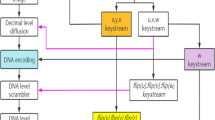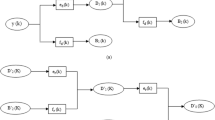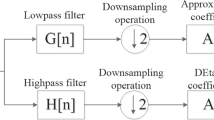Abstract
Robust zero-watermarking is an effective and distortion-free technique for copyright protection and has become a research hotspot in the field of digital watermarking. In the face of weak robustness and security of existing schemes, this paper presents a novel robust and secure color image zero-watermarking algorithm based on majority voting pattern and hyper-chaotic encryption. In the proposed algorithm, firstly an original color image is decomposed by one-level discrete wavelet transform (DWT) and the corresponding low-frequency components of three channels are partitioned into blocks. Then, to resist strong attacks, we construct a distinguishable robust binary feature matrix extracted from all blocks and color components by using a combination of Frobenius norm in the singular value decomposition (SVD) domain and majority voting pattern. To promote security, a binary copyright logo is confused and diffused by hyper-chaotic Lorenz system. Finally, it performs a bitwise exclusive-or operation on the binary feature matrix and the encrypted copyrighted logo to obtain a zero-watermark signal. Experimental results indicate that in addition to the high-level security, the proposed zero-watermarking algorithm also has a stronger robustness against common geometric and non-geometric attacks, including rotation, scaling, filtering, JPEG compression and noise addition, compared with some existing typical zero-watermarking and traditional watermarking methods.











Similar content being viewed by others
References
Abd El-Latif AA, Li L, Wang N, Han Q, Niu X (2013) A new approach to chaotic image encryption based on quantum chaotic system, exploiting color spaces. Signal Process 93(11):2986–3000
Abd El-Latif AA, Li L, Niu X (2014) A new image encryption scheme based on cyclic elliptic curve and chaotic system. Multimed Tools Appl 70(3):1559–1584
Abd El-Latif AA, Abd-El-Atty B, Shamim Hossain M, Abdur Rahman MD, Gupta AABB (2018) Efficient quantum information hiding for remote medical image sharing. IEEE Access 6:21075–21083
Abd El-Latif AA, Abd-El-Atty B, Talha M (2018) Robust encryption of quantum medical images. IEEE Access 6:1073–1081
Abd EL-Latif AA, Abd-El-Atty B, Venegas-Andraca SE (2019) A novel image steganography technique based on quantum substitution boxes. Opt Laser Technol 116:92–102
Belazi A, Khan M, Abd El-Latif AA, Belghith S (2016) Efficient cryptosystem approaches: S-boxes and permutation-substitution-based encryption. Nonlinear Dynam 87(1):337–361
Belazi A, Abd El-Latif AA, Diaconu A-V, Rhouma R, Belghith S (2017) Chaos-based partial image encryption scheme based on linear fractional and lifting wavelet transforms. Opt Lasers Eng 88:37–50
Chang CC, Lin PY (2008) Adaptive watermark mechanism for rightful ownership protection. J Syst Softw 81:1118–1129
Chen H, Luo T, Yu M, Jiang G, Zhou H, Mo K (2012) A zero-watermark method based on texture characteristic of image blocks for stereo images. IEEE 2012 Int Conf Ind Control Electron Eng (ICICEE), pp 490–493
Chou CH, Wu TL (2003) Embedding color watermarks in color images. EURASIP J Appl Signal Process 1:32–40
Computer Vision Group (CVG). [Online]. Available: http://decsai.ugr.es/cvg/index2.php
Ehsaee S, Jamzad M (2014) Robust zero watermarking for still and similar images using a learning based contour detection. AISP 2013. CCIS 427:13–22
Gao GY, Jiang GP (2011) Zero-bit watermarking resisting geometric attacks based on composite-chaos optimized SVR model. J China Univ Posts Telecommun 18(2):94–101
Gao GY, Jiang GP (2015) Bessel-Fourier moment-based robust image zero-watermarking. Multimed Tools Appl 74(3):841–858
Ghadi M, Laouamer L, Nana L, Pascu A (2016) A novel zero-watermarking approach of medical images based on Jacobian matrix model. Secur Commun Netw 9(18):5203–5218
Huynh-The T, Hua C-H, Tu NA, Hur T, Bang J, Kim D, Amin MB, Ho Kang B, Seung H, Lee S (2018) Selective bit embedding scheme for robust blind color image watermarking. Inf Sci 426:1–18
Kang X, Zhao F, Lin G, Chen Y (2018) A novel hybrid of DCT and SVD in DWT domain for robust and invisible blind image watermarking with optimal embedding strength. Multimed Tools Appl 77(11):13197–13224
Li L, Abd-El-Atty B, Ghoneim A (2017) Quantum color image encryption based on multiple discrete chaotic systems, 2017 Federated Conference on Computer Science and Information Systems (FedCSIS) Vol 11
Li L, Shamim Hossain M, Abd El-Latif AA, Alhamid MF (2017) Distortion less secret image sharing scheme for internet of things system, Cluster Computing, 1–15
Liu X, Chen B, Coatrieux G, Shu H (2017) Color image zero-watermarking based on SVD and visual cryptography in DWT domain. Eighth international conference on graphic and image processing (ICGIP 2016). Proc SPIE 10225:102251N
Lu J, Huang Q, Wang M, Li L, Dai J, Chang C-C (2015) Zero-watermarking based on improved ORB features against print-cam attack. IWDW 2014. LNCS 9023:187–198
Parah SA, Loan NA, Shah AA, Sheikh JA, Bhat GM (2018) A new secure and robust watermarking technique based on logistic map and modification of DC coefficient. Nonlinear Dynam 93(4):1933–1951
Rai A, Singh HV (2017) Machine learning-based robust watermarking technique for medical image transmitted over LTE network. J Intell Syst 27(1):105–114
Rani A, Bhullar AK, Dangwal D, Kumar S (2015) A zero-watermarking scheme using discrete wavelet transform. Procedia Comput Sci 70:603–609
Shaik A, Masilamani V (2018) Zero-watermarking in transform domain and Quadtree decomposition for under water images captured by robot. Procedia Comput Sci 133:385–392
Shakeri M, Jamzad M (2011) A robust zero-watermark copyright protection scheme based on DWT and image normalization, PSIVT 2011, part II. LNCS 7088:359–370
Singh A, Dutta MK (2017) A robust zero-watermarking scheme for tele-ophthalmological applications. J King Saud Univ Comput Inf Sci available online
Su Q, Niu Y, Wang G et al (2014) Color image blind watermarking scheme based on QR decomposition. Signal Process 94(1):219–235
Su Q, Yuan Z, Liu D (2019) An approximate schur decomposition-based spatial domain color image watermarking method. IEEE Access 7(1):4358–4370
Thanh TM, Tanaka K (2017) An image zero-watermarking algorithm based on the encryption of visual map feature with watermark information. Multimed Tools Appl 76(11):13455–13471
Tsai H-H, Lai Y-S, Lo S-C (2013) A zero-watermark scheme with geometrical invariants using SVM and PSO against geometrical attacks for image protection. J Syst Softw 86:335–348
USC-SIPI image database. [Online]. Available: http://sipi.usc.edu/database/
Vellaisamy S, Ramesh V (2014) Inversion attack resilient zero-watermarking scheme for medical image authentication. IET Image Process 8(12):718–727
Wang XY, Wang MJ (2008) A hyper-chaos generated from Lorenz system. Phys A 387(14):3751–3758
Wang C-p, Wang X-Y, Xia Z-q, Zhang C, Chen X-j (2016) Geometrically resilient color image zero-watermarking algorithm based on quaternion exponent moments. J Vis Commun Image Represent 41:247–259
Wang C-p, Wang X-y, Chen X-j, Zhang C (2017) Robust zero-watermarking algorithm based on polar complex exponential transform and logistic mapping. Multimed Tools Appl 76(24):26355–26376
Wang C, Wang X, Xia Z, Zhang C (2019) Ternary radial harmonic Fourier moments based robust stereo image zero-watermarking algorithm. Inf Sci 470:109–120
Wen Q, Sun TF, Wang SX (2003) Concept and application of zero-watermark. Acta Electron Sin 31(2):214–216
Xiang-Guang X (2018) A zero watermarking scheme with strong robustness in spatial domain. Acta Automat Sin 44:1
Yan X, Wang S, Abd El-Latif AA, Niu X (2013) New approaches for efficient information hiding-based secret image sharing schemes. SIViP 9(3):499–510
Ye T (2011) Robust zero-watermark algorithms in hybrid transform domains based on the parity of Norm's highest digit. Futur Int Inf Syst LNEE 86:73–81
Zhang Y, Jia C, Wang X, Wang K, Pei W (2012) Robust zero-watermark algorithms based on numerical relationship between adjacent blocks. J Electron (China) 29(5):392–399
Zhou W, Yu M, Yu S-M, Jiang G-Y, Ge D-F (2012) A zero-watermarking algorithm of stereoscopic image based on hyperchaotic system. Acta Phys Sin 61(8):117–126
Zou B, Du J, Liu X, Wang Y (2018) Distinguishable zero-watermarking scheme with similarity-based retrieval for digital rights management of fundus image. Multimed Tools Appl 77(21):28685–28708
Acknowledgements
This work was supported by the Scientific Research Program Funded by Shaanxi Provincial Education Department (Program No.15JK1504) and the National Natural Science Foundation of China (Grant No. 61671374, 61671376, 61771386).
Author information
Authors and Affiliations
Corresponding author
Ethics declarations
Conflict of interest
The authors declare that they have no conflict of interest.
Additional information
Publisher’s note
Springer Nature remains neutral with regard to jurisdictional claims in published maps and institutional affiliations.
Rights and permissions
About this article
Cite this article
Kang, Xb., Lin, Gf., Chen, Yj. et al. Robust and secure zero-watermarking algorithm for color images based on majority voting pattern and hyper-chaotic encryption. Multimed Tools Appl 79, 1169–1202 (2020). https://doi.org/10.1007/s11042-019-08191-y
Received:
Revised:
Accepted:
Published:
Issue Date:
DOI: https://doi.org/10.1007/s11042-019-08191-y




